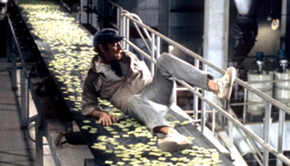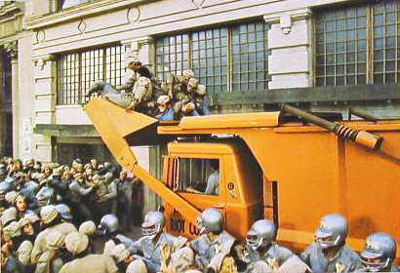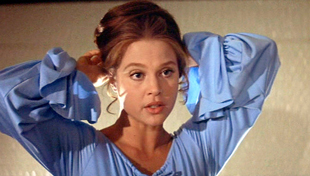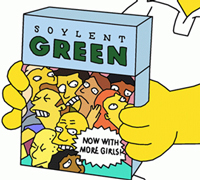
 |
|
|
|
Making a futuristic science fiction movie that lasts has never been easy, as the future just won't "stay still". Makers of cheap pictures rarely looked further than ten years ahead, in the hope that clothing styles wouldn't change radically. When the year 2001 rolled around critics noted that Stanley Kubrick hadn't foreseen the end of the Cold War or the demise of Pan Am. And when Wim Wenders' marvelous Until the End of the World dared to peek only nine years ahead, it failed to predict The Internet. Then again, who did? 
At this particular moment the gold standard for Sci-fi futures is still Ridley Scott's stylish Blade Runner, much of which still looks better than your average high-fashion magazine. Even the best efforts of the past date quickly because of the Devil that lives in the Details. 1973's Soylent Green is immediately distinguishable from 90% of what passes for film Sci-fi by the fact that it has no monsters. Thanks to good acting and direction in service of an interesting idea, it's still remembered when other ecological catastrophe pictures have faded -- Z.P.G., for one. The ecological movement gained public acceptance in the 1950s with books stressing the planet's delicate balance of nature. Then came Rachel Carson's 1962 book The Silent Spring and its warning of the effects of unrestrained pesticide use. Science Fiction had predicted or concocted dozens of possible ways to eradicate the world's life, but movies before the late 60s stuck mostly to anti-nuke messages. The British teleseries Doomwatch specialized in environmental threats, but ecological disaster movies did not take the high ground. Adapted from a thoughtful book, 1970's ugly No Blade of Grass stressed post-apocalyptic rape and plunder amid its sledgehammer shock visuals. Soylent Green is sourced in a fascinating novel by Harry Harrison that addresses the issue of overpopulation. The movie has a mixed heritage. Still-liberal Charlton Heston lauded its important message and chose the film as a good link in his chain of Sci-fi hero roles that started with his 1968 mega-hit Planet of the Apes. MGM's despised production chief James Aubrey almost certainly okayed the picture because it could be made for a pittance. We're informed that Soylent Green was the last film to use the run-down street sets on the MGM back lot, before the studio sold them off to real estate developers. Stanley R. Greenberg's screenplay works some effective commercial changes on Harrison's impressive -- but depressing -- book, adding some upbeat passages, action scenes and the central conspiracy that has kept Soylent Green enough of a cultural buzzword to be quoted on The Simpsons. 
Manhattan of 2022 is home to 22 million people, most of whom are homeless and live in abject poverty. With the collapse of the environment, real food is almost unknown. The Soylent Corporation has stepped in to find ways to feed the population. Heavy sellers are Soylent Orange wafers, made from plankton. The few citizens with jobs cling to them in desperation, including Detective Thorn (Charlton Heston), who lives with his elderly partner and crime researcher Solomon Roth (Edward G. Robinson, in his last role). Thorn welcomes the opportunity to investigate a murder in the lavishly wealthy Chelsea West apartments, isolated from the rest of Manhattan behind security gates. The dead man is bigwig William Simonson (Joseph Cotten). Thorn intimidates bodyguard Tab Fielding (Chuck Connors) and Simonson's live-in concubine Shirl (Leigh Taylor-Young), who comes with the apartment and is therefore called "Furniture". Thorn wastes no time raiding the rich man's larder of fresh organic foodstuffs. Thorn thinks that Simonson was murdered but political pressure is applied to his police Chief Hatcher (Brock Peters) to stop the investigation. After being assigned to riot detail when supplies of the new food Soylent Green run out, Thorn begins an affair with Shirl. But their plans are cut short when Sol discovers the secret behind Simonson's murder, and decides that he no longer wants to live. He turns himself in to a communal suicide parlor, where volunteers are treated to twenty minutes of beautiful music and images of the beautiful Earth that is no more. Soylent Green is definitely a split decision movie: the parts that work are very well done, even inspired. Other aspects can only be listed as an honest try under difficult conditions. Charlton Heston plays the policeman Thorn as one of his standard brawny heroes, yet also impresses as a normal guy stuck in a lousy environment. Everything is rationed, and the only reason people can take the crowding and discomfort is because most of them don't remember when things were better. Heston and Edward G. Robinson make a fine team ... Robinson's Sol keeps harping on how wonderful "real food" was, and Thorn ignores him until he gets a taste from his confiscated wares -- fresh fruit, strawberry jam, real beef. Heston mimes the wonder of discovering these heavenly tastes for the first time, and makes us feel the joy. The Strawberry Jam is just a bit of taste left on a spoon that Thorn steals from bodyguard Tab Fielding's apartment. Since it costs $150 "D's" per jar, it indicates that Tab may have been paid off to conspire in Simonson's death. Soylent Green shows the cops surviving by confiscating what they can; the payola is institutionalized up and down the ranks of civil servants, and Thorn has to pay a percentage to his Chief. Yet they're all behaving within their ethical standards. As Simonson's property, Shirl doesn't bat an eye when Thorn shows up "to ask questions" and then calmly orders her to go to bed with him. The film makes a backhanded feminist statement when Shirl accepts the arrangement as a matter of course. Hollywood values peek in when the pair makes plans to become a couple. Of course, who can say if Shirl is willing to live in Thorn's cramped and ugly apartment? 
The movie is a gift to Edward G. Robinson, and Robinson is a gift to us. Solomon Roth makes a Jewish toast to Thorn with every meal, and his nostalgic reveries remind us of what we have but could lose, should the environment deteriorate and civilization collapse. Clearly not in the best of health, Robinson gives the part his all. Neither he nor director Richard Fleisher milk the melodrama of the already-charged situation. Except for a tear or two ("old people tend to cry a lot") he experiences the death parlor as just another surplus body in the Malthusian imbalance. Soylent Green was the fine actor's last film, and he was almost stone deaf when he filmed it.. Clearly an actor with a lot of influence on his projects, Heston steers the movie to a conclusion that affords him a big scene, as at the end of his Apes film and the embarrassing crucifixion that finishes The Omega Man. Thorn exits like Dr. Miles Bennell of Invasion of the Body Snatchers, more or less screaming "You're next!" The big secret of Soylent Green is difficult to spoil -- next to Charlie Kane's flexible flyer, it's the most frequently spoiled film surprise of them all. Before 2001 and Star Wars filmed sci-fi always had difficulty affording futuristic special effects and settings. Cost cutting doesn't cripple Soylent Green but it doesn't help, either. Besides hiring hundreds of extras for a few days to shoot all those crowd scenes, the movie is pretty cheap. A few Matthew Yuricich matte paintings barely sketch in the contours of the stagnant city, and even those aren't integrated well -- Charlton Heston runs "behind" a background building when rushing to save his buddy Sol. We can also see that the ragged MGM New York Street exterior set is barely strong enough to stand up -- the sheets of fake brick cladding look ready to peel off and fall. The poster image of dozens of people being scooped up by enormous tractors is reduced to a pair of ordinary garbage trucks, with a few daring stuntmen allowing themselves to be hoisted into the air. Nobody explains how the trucks get through the streets without crushing the crowds wholesale. The production design is okay, but some ideas are pretty pitiful. Having the riot police wear standard football helmets seems lazy, while audiences laughed at sight of the upright arcade video game that Shirl plays in Simonson's apartment. It's the original "futuristic" Pong game that in 1973 was positioned somewhere in the lobby of most of Westwood's upscale movie theaters. They might as well have put an Edsel car in the movie, or posters of Donnie & Marie Osmond. 
In keeping with its theme of environmental collapse, the movie has an intentionally unappetizing appearance. The exception to the icky image texture is the suicide salon scene, in which Sol essentially gets to watch an MGM two-reeler in CinemaScope, with beautiful color. With vibrant classical music playing, we see some specially shot material but also outtakes from the MGM stock footage library, including deer from The Yearling and an aerial shot of sheep from Far from the Madding Crowd. Someone with a sharper memory could identify which MGM westerns of the '50s and '60s provided the outtakes of idyllic cabins and mountains. We don't know who edited this film within a film, but the movie's so-so opening montage is by Chuck Braverman, and is accompanied by increasingly sinister music that reminds us of the assassin exam film from The Parallax View. The film's future dystopia is just credible enough to make viewers think. It's similar to Blade Runner in that a cop hero chases and shoots bad guys while uncovering a "shocking" conspiracy. I think society will have to face crippling overpopulation long before duplicate human beings become a serious issue. The awful New York of Soylent Green is all but here in the worst corners of our big cities -- the crumbling infrastructure and the denial of social services is making that part of the picture come true soon enough. Couple this feeling of just-around-the-corner Future Shock with the strong performances by Heston and Robinson, and Soylent Green still stands up as a sci-fi thriller with integrity. It is said to be MGM's only moneymaker from 1973 save for Westworld. The movie has some fine supporting actors. Brock Peters played a soldier under Charlton Heston's command in Major Dundee while Paula Kelly had a standout part in The Andromeda Strain. The leader of Sol's group of information activists is Celia Lovsky, a wonderful face familiar from many movies and TV shows since 1930. Warner Home Video's Soylent Green Blu-ray looks far better than the miserable prints MGM distributed to neighborhood theaters in 1973, when many normal movies tended to look greenish. The film's daytime exteriors are tinted green-yellow, and in theaters they looked as if they'd been run through a urinal. This HD transfer retains much of the grain, especially in the matte shots and the green-tinted daytime scenes, which look to be long optical sections. It is also sharper, brighter and clearer than I've ever seen this film before, and a big improvement over the somewhat blurry DVD. 
The extras are all recycled from earlier editions. Director Richard Fleischer joins actress Leigh Taylor-Young on the commentary track. Although we hear some interesting anecdotes they mostly react to what they see on screen, and the comments thin out in the final reels. We would have liked to hear more about the changes made to the Harry Harrison novel -- in the original Shirl is simply the girlfriend of a murdered racketeer. She lives with Thorn in the tenement apartment until misery and squalor gets her down, whereupon a whole family moves in to take her place. There is no suicide parlor and no "special revelation" at the end of the show: Thorn merely gets busted for investigating a forbidden issue and goes back on street-cop duty. Two original featurettes are included, one a making-of piece and another celebrating Edward G. Robinson's birthday during the shoot -- he and Heston show up in costume. An original trailer is included as well.
On a scale of Excellent, Good, Fair, and Poor,
Soylent Green Blu-ray rates:
Reviews on the Savant main site have additional credits information and are often updated and annotated with reader input and graphics. Also, don't forget the 2010 Savant Wish List. T'was Ever Thus.
Review Staff | About DVD Talk | Newsletter Subscribe | Join DVD Talk Forum |
| ||||||||||||||||||